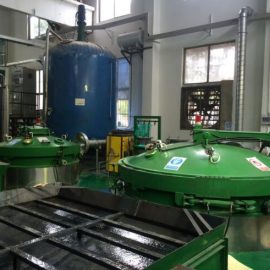Carbon Classification Of Carburizing Heat Treatment
Carburizing heat treatment carburizing is generally for steel, steel carburizing is steel in the carburizing medium heating insulation, so that carbon atoms into the surface of steel, the surface of the carbon concentration changes, so as to obtain a certain surface carbon content and a certain concentration gradient of the heat treatment process.
The workpiece after carburizing heat treatment is quenched and tempered at low temperature, so that the surface has high hardness and wear resistance, and the heart still maintains good plastic toughness, so as to meet the requirements of the use of the workpiece outside hard and inside tough.Nitriding: after nitriding, the surface of the parts forms a layer of nitrogen compounds, which can have high hardness, wear resistance, fatigue resistance and certain corrosion without quenching, and the deformation is also very small.
Carbonitriding: Also called cyanidation.Carbonitriding is a treatment method that simultaneously seeps carbon atoms and nitrogen atoms into the surface of steel parts to form a carbonitriding layer to improve the hardness, wear resistance and fatigue strength of the workpiece.
Carburizing heat treatment in the purpose of carburizing is to make the machine parts to obtain higher surface hardness, wear resistance and high contact fatigue strength and bending fatigue strength.
Carburizing according to the aggregate state of the carburizing agent is divided into solid carburizing, liquid carburizing, gas carburizing three kinds.
1. Solid carburizing: the workpiece is placed in the sealed box filled with granular carburizing agent for carburizing.
2. Paste carburizing: the surface of the workpiece with paste carburizing agent coated carburizing.
3. Salt bath carburizing, liquid carburizing: the workpiece is carburized in molten salt containing carburizing agent.
4. Gas carburizing: the carburizing of the workpiece in the gas containing carbon.
5. Drip carburizing: benzene, alcohol, haldern, kerosene and other liquid carburizing agent directly drop into the furnace cracking gas carburizing.
6. Ion carburizing: in lower than 1×10^5Pa (usually 10~10^-1Pa) carburizing atmosphere, using the glow discharge produced between the workpiece (negative) and the anode
7. Fluid-bed carburizing: Carburizing in a fluid-bed containing carbon.
8. Electrolytic carburizing: a power supply is connected between the workpiece as a cathode and the graphite anode placed in the salt bath with it.
9. Vacuum carburizing: carburizing under conditions of 1×10^5Pa (usually 10~10^-1Pa) in the sub-carburizing atmosphere.
10. High temperature carburizing: carburizing at above 950℃.
11. Local carburizing: Carburizing of a certain part or some areas of the workpiece only.
12. Through carburizing: thin workpiece from the surface to the center of all the penetration of carburizing.
13. Carbide diffusion enhanced carburizing: the carburizing surface to obtain fine dispersed carbides to improve the service ability of the workpiece.
14. Thin layer carburizing: after the workpiece carburizing and quenching, the total surface hardening layer depth or effective hardening layer depth is less than or equal to 0.3mm carburizing.
15. Deep carburizing: after carburizing and quenching, the effective hardening layer depth of the workpiece is more than 3mm carburizing.
16. Recarburization: after the workpiece is decarburized for some reason, it is carburized to restore the initial carbon content.
17. Carbon potential: a parameter representing the ability of carbon-containing atmosphere to change the carbon content on the workpiece surface at a certain temperature. It is usually monitored with an oxygen probe and quantitatively monitored with the balanced carbon content of low-carbon carbon steel tube sheet in a carbon-containing atmosphere.
18. Dew point: The temperature at which water vapor in an atmosphere begins to condense.The dew point is proportional to the moisture content in the atmosphere, and the higher the moisture content in the atmosphere, the higher the dew point.In gas carburizing, the carbon potential of the atmosphere can be determined indirectly by measuring the dew point.
19. Carbon content distribution: along the carburizing workpiece and the surface perpendicular to the distribution of carbon in the carburizing layer.
Editing by Francis Lee

Controlled Atmosphere Pit Type Carburizing Furnace
Learn More :
Effect of Tension Annealing-Induced Anisotropy on Magnetic Properties of Nanocrystalline Alloys Research Progress On Annealing Process Of Amorphous Nanocrystalline Soft Magnetic Alloys Quenching Oil Tank Oil Fume Purification Device


Contact us
Your email address will not be published. Required fields are marked *